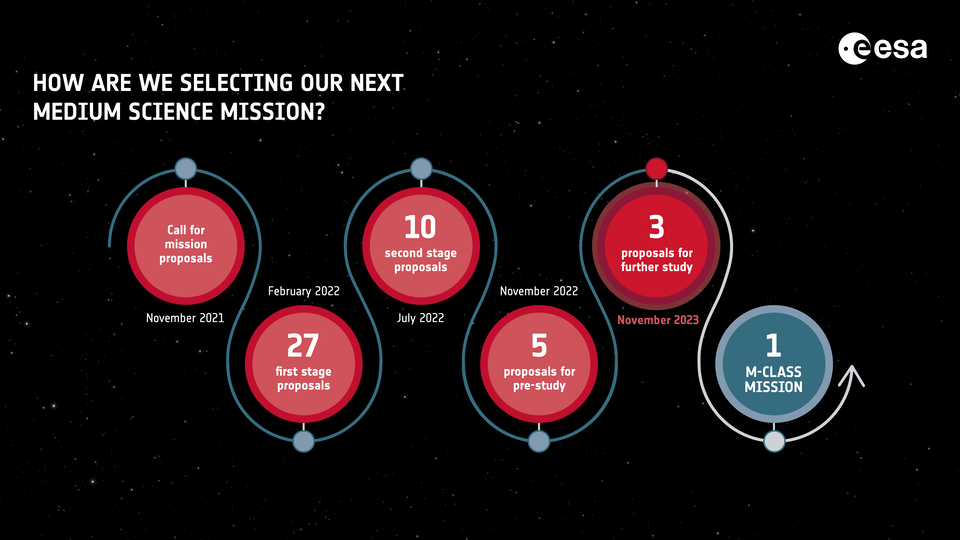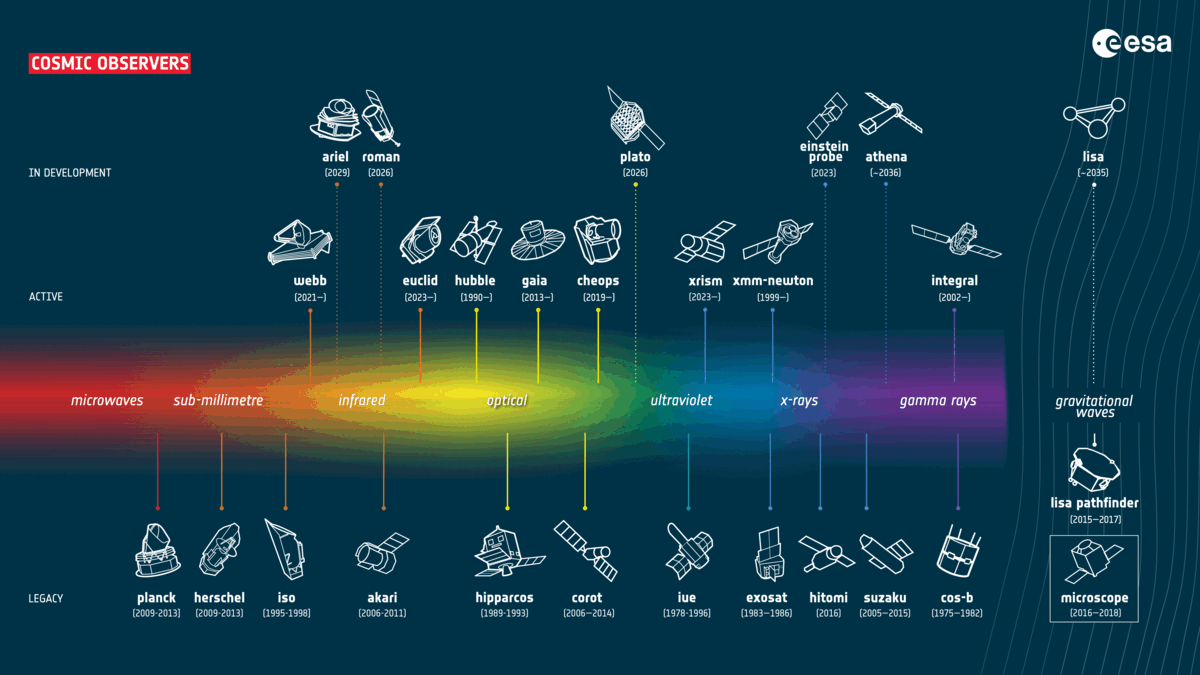Final three for ESA’s next medium science mission
The space science community has narrowed down the shortlist for ESA’s next ‘medium’ mission to three finalists: M-Matisse, Plasma Observatory and Theseus. Following further study, one will be selected for implementation as the newest addition to ESA’s space science mission fleet.
Medium (or ‘M-class’) missions are a key component of ESA’s Science Programme that enable Europe to answer important scientific questions. Solar Orbiter, Euclid and Mars Express are examples of flying M-class missions, while Plato and Ariel are currently being built for launch in the next six years.
From the Sun to dark matter, ESA's existing M-class missions cover a huge range of space science topics. The newest addition would complement the fleet by shedding light on the habitability and evolution of Mars (M-Matisse), exploring the plasma environment around Earth (Plasma Observatory) or studying high-energy, short-lived events across the cosmos (Theseus).
In December 2021, ESA called for proposals for the next M-class mission, pencilled in for launch in the mid-2030s. From 27 responses, experts within and outside ESA used rigorous scientific and technical assessments and a peer review selection process to narrow down the number of proposals in the running. In November 2022, five mission concepts remained.
Between January and September 2023, these final five went through ‘Phase 0’ studies – an undertaking that explores the expected science that could be achieved with each mission, as well as coming up with a preliminary mission design.
Today, ESA’s Science Programme Committee endorsed the decision that three of the five – M-Matisse, Plasma Observatory and Theseus – will enter a more detailed study period (Phase A) to continue exploring their potential. More information about the science goals of each mission can be found at the end of this article.
“All five mission proposals that went through Phase 0 were excellent – they addressed unique and exciting topics, and were achievable in the mid-2030s timeframe, so it was really difficult to come to a final decision,” explains ESA Director of Science, Carole Mundell.
“We established a panel of experts from ESA Member States to review the candidate missions. The reviewers followed a strict selection process, which included looking at science value, scientific feasibility, timeliness and complementarity with other projects.”
Cecilia Hernández of AEE (Agencia Espacial Española), Spain, Chair of the Science Programme Committee, adds: “We would like to congratulate all five proposals, each of which showed excellent promise to shed light on unanswered space science questions. We look forward to the many discoveries that will be made by the final selected mission.”
During the upcoming Phase A studies, for each candidate mission two different aerospace companies will run a detailed study, resulting in a more comprehensive design for each mission. It is expected that one candidate mission will be chosen by mid-2026.
This mission will ultimately form part of ESA’s fleet of science missions, which cover a wide range of ambitious space science themes. Whether it is M-Matisse, Plasma Observatory or Theseus, it will be a valuable addition to the squad.
M-Matisse would study Mars using two spacecraft, each carrying an identical set of instruments to observe Mars simultaneously from two different locations in space. In particular, M-Matisse would shed light on how the solar wind influences Mars’s atmosphere, ionosphere and magnetosphere. The mission aims to investigate the impact of these interactions on Mars's lower atmosphere and surface, which is a key aspect to understand the Red Planet’s habitability, as well as the evolution of its atmosphere and climate.
Plasma Observatory is a seven-spacecraft mission to study the environment of electrically charged particles (called a plasma) around Earth. It would focus on two questions: how are particles energised in space plasmas? What processes dominate energy transport and drive interactions between the different regions of Earth’s magnetospheric system? Plasma Observatory would complement ESA’s current and planned missions looking at the Sun-Earth interaction to support our understanding of how the solar wind affects our planet, ultimately helping us keep life and technology safe from its effects.
Theseus is a multi-instrument mission focusing on high-energy, short-lived events in the cosmos. In particular, Theseus would look at gamma-ray bursts near and far. Nearby, shorter-lived, gamma-ray bursts are likely counterparts to gravitational waves released by merging neutron stars. Distant, longer-lived gamma-ray bursts would help us understand more about the emergence of the first galaxies in the Universe. Overall, Theseus would cover a broad spectrum of science, from stellar astrophysics and the effects of stellar activity on exoplanets, to the physics of matter accretion and particle acceleration processes.
New way forward for future large (L-class) mission: NewAthena
ESA’s Science Programme Committee has also today endorsed a rescoped version of Athena, which was selected as a large mission in 2014. Designed to capture X-ray light to study the hot and energetic Universe, the way forward for 'NewAthena' is expected to transform our knowledge in almost every corner of modern astrophysics.
ESA, the science community, instrument teams, and international partners have worked hard to come up with a simplified mission design that meets the cost requirements set by the Science Programme Committee but nevertheless delivers scientific excellence and ambition in line with that expected of a flagship L-class mission.
The adoption of NewAthena is expected in 2027, with launch planned for 2037.




